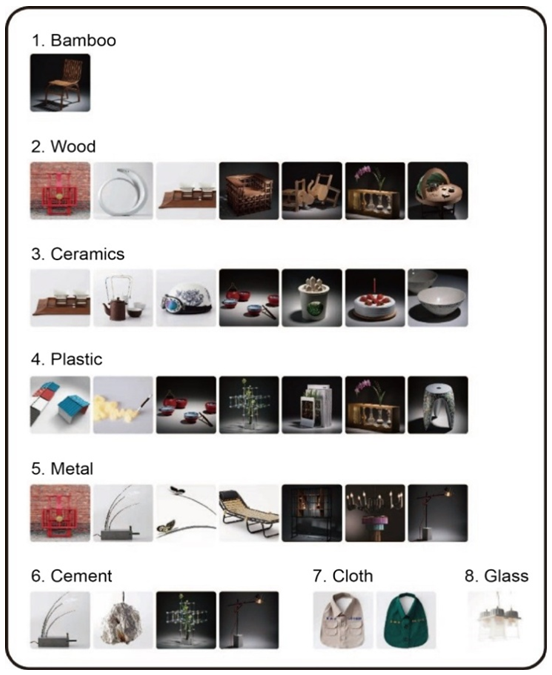-
Paper Information
- Previous Paper
- Paper Submission
-
Journal Information
- About This Journal
- Editorial Board
- Current Issue
- Archive
- Author Guidelines
- Contact Us
International Journal of Arts
p-ISSN: 2168-4995 e-ISSN: 2168-5002
2017; 7(1): 6-16
doi:10.5923/j.arts.20170701.02

Identifying Taiwanese Design Styles by Examining the Curating Process Employed by the Go with the East Wind Design Association
1The Graduate Institute of Design Science, Tatung University, Taipei, Taiwan
2Department of Industrial Design, Tatung University, Taipei, Taiwan
Correspondence to: Chia-Wei Kuo, The Graduate Institute of Design Science, Tatung University, Taipei, Taiwan.
| Email: |  |
Copyright © 2017 Scientific & Academic Publishing. All Rights Reserved.
This work is licensed under the Creative Commons Attribution International License (CC BY).
http://creativecommons.org/licenses/by/4.0/

Recent advances in the high-tech industries worldwide have severely changed Asian economic development, transforming traditional industrial industries into knowledge-based or cultural and creative industries. In response, the design industry of Taiwan has been organizing various exhibitions since 2004 to boost product sales and create diverse economic benefits. Among these exhibitions, those curated by the cultural and creative industry have driven Taiwanese economic development significantly. To examine the current state of exhibitions in Taiwan, this study analyzed the curating model and execution methods employed by Go with the East Wind, a Taiwanese design association, to further identify Taiwanese design styles of cultural and creative products. This study conducted 3 years of field research and an expert interview with professionals from Go with the East Wind to analyze the curating process and its execution methods in detail. By examining 54 exhibition items designed by Go with the East Wind, this study formulated a set of design guidelines for Taiwanese cultural and creative products and observed the correlation between these products and Taiwanese local cultures and techniques to identify prevalent Taiwanese design styles. In addition, this study examined the composition of the exhibition procedure of Go with the East Wind, which can serve as a reference for curating other exhibitions.
Keywords: Cultural and creative industry, Go with the East Wind, Taiwanese design style
Cite this paper: Chia-Wei Kuo, Fu-Yuan Li, Identifying Taiwanese Design Styles by Examining the Curating Process Employed by the Go with the East Wind Design Association, International Journal of Arts, Vol. 7 No. 1, 2017, pp. 6-16. doi: 10.5923/j.arts.20170701.02.
Article Outline
1. Introduction
1.1. Study Motivation and Objectives
- To develop a corporation or an artist, in addition to creating a production and distribution model, the corporation or artist should run exhibitions as it is the most efficient method to increase publicity and promote products. Statistics show that 1,600 trade exhibitions were organized in the United Kingdom in 2010, and that approximately 13 million people attended the said exhibitions, spending over £1.4 billion [1]. The Central News Agency reported that 564 exhibitors from 19 countries participated in the 2013 Creative Expo Taiwan, setting up 1,035 booths. The event attracted over 100,000 visitors and the total value of sales (exposition sales and sales orders) exceeded NT$330 million, indicating the economic value and commercial opportunities created by exhibitions. Furthermore, from the perspective of long-term goals and benefits, design exhibitions improve the public’s aesthetic appreciation, increase the acceptance of creativity and novelty, and create an opportunity for designers to directly contact consumers and receive feedback. To examine the current state of design exhibitions in Taiwan, this study analyzed the events organized by Go with the East Wind. This study explored the curating process of the association by conducting field research and an expert interview, generated a model for curating future design exhibitions by conducting expert meetings, and identified prevalent Taiwanese design styles by examining the products of the association.
1.2. Definitions of Exhibition and Curating Model
- An “exhibition” generally refers to an event that displays products at a certain time and location to the public or professional experts for commercial, conceptual, or academic exchange purposes. By organizing exhibitions, curators can present distinctive theme styles or spirits in a 3D, 2D, or multimedia form. In addition, curators can increase the publicity of the exhibition by directly exchanging or communicating with visitors. Because various exhibitions are currently being vigorously developed, curating models and execution methods have become a major focus for curators and designers. Thus, this study examined the meaning and value of exhibitions and explored the abilities and qualifications required for a curator to organize cultural and creative exhibitions to further analyze the composition of exhibitions.The word “exhibit” comes from the Latin word “exhibere,” meaning “to show, to have exhibits, or to display.” Lin Ping (director of the Taipei Fine Arts Museum) defined “exhibition” as “a form of transmission that is adequately organized, structured, and visually appealing.” Exhibitions are composed of tangible and intangible objects that form a communication system, in which each participating product can be considered as a sign that carries meaning. In other words, an exhibition can be considered a communication process [2].Burcaw [3] defined “exhibition” as “an assemblage of objects of artistic, historical, scientific, or technological nature, through which visitors move from unit to unit in sequence designed to be meaningful instructionally and/or aesthetically.” In addition, he categorized exhibitions into four types (i.e., aesthetic, entertaining, factual, and conceptual), stating that the objectives of exhibitions are to create meaning and aesthetical experiences. This study defined exhibitions as a planned visual installation and cultural behavior that combine cultures, arts, entertainment, and aesthetics. Visitors can understand the spirit or cultural meaning of an exhibition through an interaction or exchange with it.A curator is generally the most crucial factor when planning an exhibition because he or she is responsible for managing the budget, personnel, and aesthetic and visual design for the entire event. Besterman [4] stated that the responsibilities of curators are to acquire, determine, collect, and manage exhibition items, to compile and supervise exhibition item collection, and to further study and examine the historic background, cultural heritage, and community influence of the collection. Kamien [5] proposed four curating models in accordance with the various roles of a curator in a curating team: (1) The developer model, in which education and promotion personnel are responsible for curating; (2) the team approach model, in which a curator, designers, and education and promotion personnel determine the division of labor through group discussions; (3) the curatorial model, in which a curator is fully responsible for the exhibition; and (4) the broker model, in which a fully developed exhibition is offered to corporations, museums, or galleries. Chen [6] listed the following qualifications for curating exhibitions for science and technology museums: (1) An ability to connect organizations; (2) possession of excellent interpersonal relationships; (3) a passion for exhibitions; and (4) possession of prior relevant knowledge.According to the aforementioned definitions, a curator must intensively study the products during the curating process and facilitate communication and negotiation by coordinating and applying teamwork. However, this study aimed to demonstrate that the primary responsibility of a curator is to identify an adequate main theme for an exhibition and use existing resources to achieve cultural transmission. By using Go with the East Wind as an example, this study analyzed their curating model by examining their curating methods and procedures, related execution strategies, and visitor feedback to provide a reference for curating related events and assisting curators in establishing their own value.
2. Literature Review
2.1. Study Motivation and Objectives
- The design exhibitions in Taiwan can be divided into several types, which include visual communication, industrial design, and space design. Since the 1960s, industrial design has received considerable attention because of the rapid development of the manufacturing industry in Taiwan, resulting in a trend for industrial design exhibitions such as the Young Designers’ Exhibition (YODEX) and the Taiwan Design EXPO organized by the Taiwan Design Center and the Taiwan Design Expo, respectively. In 2007, Taiwan Designers’Web organized the first Taiwan Designers’ Week, demonstrating the collective power of Taiwanese designers. The Taipei World Design Expo 2011 was organized on an international scale, marking a new era for exhibitions. Addressing social concerns by employing certain curating models has become a new trend for the field of modern design exhibition. This study analyzed the following design exhibitions, which were organized on the largest scale and attracted the highest number of participants in Taiwan, to explore the current state of design exhibitions.
2.1.1. YODEX
- In the 1960s, design education started to gain prevalence in Taiwan. After the Ming Chi Institute of Technology established the first design department in Taiwan, other universities in Taiwan began to follow suit as well. Because design education was in a formative stage of development, establishing such departments laid a foundation for design education in Taiwan, cultivating numerous design talents and substantially influencing the development of the Taiwanese design industry [7].In 1975, after design education gained prevalence, universities in Taiwan started organizing joint exhibitions for graduate design projects. In 1989, such joint exhibitions were officially named the YODEX, the largest student exhibition worldwide. This exhibition not only serves as a platform for design graduates to showcase their works, but also enables companies from the design industry to recruit young designers to collaborate on creating excellent products. In recent years, the YODEX has achieved new records of exhibitor and visitor numbers several times. Every year, this international event attracts design education institutions worldwide and a high number of participants [7].According to statistics compiled by the Industrial Development Bureau (IDB) under the Ministry of Economic Affairs, in May 2012, the 32st YODEX (Figure 1) attracted a total of 145 design departments, including 124 departments from 59 schools in Taiwan and 21 schools from eight other countries (including the United Kingdom, Italy, Canada, New Zealand, Australia, Mexico, and Thailand). This event attracted over 3,700 entries, 8,400 student designers, and 97,000 visitors, and making it the largest exhibition worldwide (IDB).
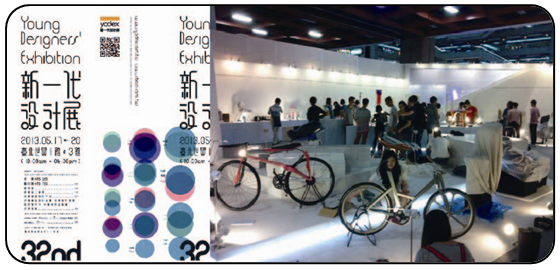 | Figure 1. Poster and event pictures of the 32th YODEX |
2.1.2. Taiwan Design Expo
- Organized by the IDB, the Taiwan Design Expo is executed by the Taiwan Design Center and co-organized by local governments. It aims to promote design, facilitate industries to increase added value through suitable product designs, contribute toward the development of the design service industry, and improve public perception of creative design and aesthetic appreciation. Since 2003, a total of six Taiwan Design Expos have been held and have attracted over 1.5 million visitors, indicating that Taiwanese design has been incorporated into mainstream public acceptance, created considerable internationally recognized added values, and achieved robust development in Taiwan.Recently, the Taiwan Design Expo has dedicated itself to promoting Taiwanese designs by applying them to daily life and various related areas (for instance, the theme of the Taiwan Design Expo was “Life Aesthetics” in 2003, which was renamed to “Design at the Edges” in 2011). Thus, new design elements were sparked when new designs collided with old ones and Eastern designs were combined with Western ones. Furthermore, this event has also enabled the public to embrace novel design concepts and indirectly enhanced its aesthetic appreciation.
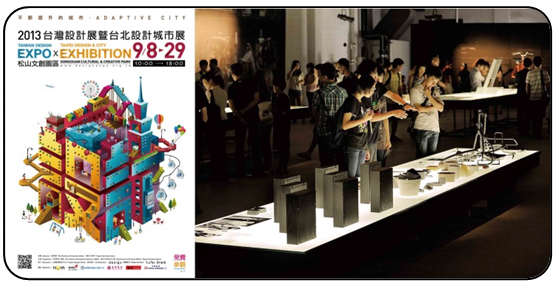 | Figure 2. Poster and venue picture of Taiwan Design Expo 2013 (Source: Taiwan Design Expo) |
2.1.3. Taiwan Designers’ Week
- The growth of the design industry has enabled Taiwanese designers to develop individual design concepts and skills. However, because of numerous limitations within the industry, they are unable to freely stimulate innovative and creative thinking. Thus, in 2006, Timothy Liao established the Taiwan Designers’Web, a designer studio that organizes design events in Taiwan and held the first Taiwan Designers’ Week in 2007. The Taiwan Designers’ Week is a platform that enables Taiwanese designers to exchange ideas, express creativity, and apply their own experiences, ideologies, and professional skills to convey an attitude toward life, address social concerns, or showcase Taiwanese design aesthetics. Every year, this event attracts numerous designers and more than 50,000 visitors, substantially influencing the public by creating opportunities for them to gradually embrace innovative design concepts [8].
 | Figure 3. Taiwan Designers’ Week (Source: Taiwan Designers’ Week) |
2.1.4. Taiwan Design Expo
- In 2011, among 19 cities from 13 countries, the International Design Alliance authorized Taipei (Taiwan Design Center) to organize the Taipei World Design Expo 2011, which attracted 1.8 million visitors, increased the international visibility of Taiwanese design, and promoted public appreciation for the value of design.The Taipei World Design Expo 2011 was held in Songshan Cultural and Creative Park, with a total exhibition space of over 4,000 ping. In addition to the theme exhibition (i.e., “Design at the Edges”), other exhibitions organized within the expo included “Int’l Industrial Design Exhibition,” “Int’l Interior Design Exhibition,” “Int’l Graphic Design Exhibition,” “Int’l Craft Design Exhibition,” and “Interdisciplinary Creative Works on Asia’s Cultural Creativity Exhibition.” Curated by a professional team, the expo invited domestic and international designers and various cultural and art performers to provide diverse content to an international audience [9].
 | Figure 4. Taipei World Design Expo 2011 (Source: Taipei World Design Expo) |
2.2. Summary
- Taiwanese design has gradually become internationally recognized through the aforementioned annual exhibitions and has assisted Taiwanese people in developing an aesthetic appreciation, a willingness to purchase cultural and creative products, and a habit of attending exhibitions. The diversity and variety of design exhibitions indicate that design exhibitions are highly valued in Taiwan. For instance, the YODEX offers student designers an opportunity to compete and showcase their works and enables companies to recruit talent for future collaboration. Similarly, the Taiwan Design Expo has been pursuing the possibility of cross-disciplinary cooperation, such as incorporating new and old elements, Eastern and Western designs, traditional and modern features, or future technologies and traditional cultures. In addition, the Taiwan Designers’Web curated the Taiwan Designers’ Week to provide a platform for Taiwanese designers to express their creativity and apply their creative concepts to brand marketing. Moreover, the success of the Taipei World Design Expo 2011 increased the momentum for Taipei toward becoming a design capital and improved an awareness of the humanities and arts in Taiwan.
3. Curating Model of Go with the East Wind
- Recently, the vigorous development of design exhibitions in Taiwan (from YODEX to the Taiwan Design Expo and the Taiwan Designers’ Week) has indicated the relevance of design exhibitions in Taiwan and continuously attracted numerous new designers or curators. To examine curating models, this study analyzed the exhibitions curated by Go with the East Wind, which has participated in the Taiwan Designers’ Week and organized several expositions for the departments of cultural affairs of various local governments. In addition, this study examined the exhibition models and exhibition item themes of Go with the East Wind by administering a 3-year long field research. An expert interview was conducted with three curators (namely Chen Jun-lian, president of Freeimage Design; William Liu, chief design officer of Go with the East Wind; and Li Fu-yuan, design director of Go with the East Wind) to understand their curating concepts and objectives. Finally, expert meetings were organized to generate a set of curating guidelines for cultural and curated exhibitions.Comprising a total of 78 Taiwanese designers, Go with the East Wind is the largest design team in Taiwan. It recruits designers from various fields such as product design, multimedia design, interior design, and integration design. Among the team, approximately 10 designers consistently receive international design awards (including the Red Dot Design Award, the iF Design Award, and the Good Design Award). By having organized themed exhibitions in recent years, this design team has applied Taiwanese design styles toward creating numerous products, which have been produced and sold in Asia. Therefore, an analysis of the design products and the organization can contributed toward identifying the current design styles of cultural and creative products and innovation methods prevalent in Taiwan.
3.1. Background and Philosophy
- Go with the East Wind was founded by seven companies. In 2012 it started actively participating in organizing cultural and creative exhibitions and developing related products in Taiwan, and has contributed toward several publicly acclaimed and recognized joint exhibitions during the Taiwan Designer’s Week, including “2011 Go with the East Wind: Prelude,” “2012 Go with the East Wind: Memory Gather,” and “2013 Go with the East Wind: Guanyin” (Figure 5).The exhibitions organized by Go with the East Wind have underscored the relevance of portraying Taiwanese people’s life and incorporating cultural elements into product design. By using a designer’s perspective, this design association aims to address everyday topics in Taiwan and apply design concepts that emphasize essential natures and support environmental protection.
 | Figure 5. Event pictures of exhibitions organized by Go with the East wind |
3.2. Curating Procedure
- This study divided the curating process implemented by Go with the East Wind into the following eight stages:Stage 1 (preparation):Hold meetings to select a curator and form a curating team. Research the latest design trends or mainstream paradigms to determine the theme of the exhibition. Create a preliminary timeline for curating the exhibition.Stage 2 (designer selection):The designer selection process is divided into two simultaneous procedures: (1) Create a list of designer nominees and officially invite them; and (2) publicly invite designers to participate.Stage 3 (workshops and design proposals):Recruit designers by holding workshops, in which they can brainstorm, propose, and share their ideas to determine a consistent design theme.The curators interviewed in this study all indicated that holding workshops for brainstorming can more easily generate a consistent style or theme for the exhibition. If a designer’s style is too “individualized” or does not conform to the main theme, his or her works may not contribute toward maintaining the consistency of the exhibition. Thus, a chief curator or the designer team must directly offe advice for modifying or recreating the design.Stage 4 (design finalization and model production):The senior consultant and chief curator of the curating team must approve each designer’s works and advise or comment on how to modify their design.Stage 5 (photoshoot):Apply designers’ image photos and product photos for commercial use according to the main theme.Stage 6 (information and publication editing):The organizer can record the curating process and product design in the form of documentaries or publications, which include information or texts related to the main theme, a curator introduction, designers’ image photos, a designer introduction, product photos, product concepts, and a list of sponsors. Stage 7 (exhibition space design and decoration):Establish an exhibition space designed to stimulate the visual sense of visitors and highlight the value of creativity in the designers’ products. Stage 8 (official opening and opening party):To increase promotional effectiveness, an opening party is generally held to generate media coverage and attract more visitors to the venue.
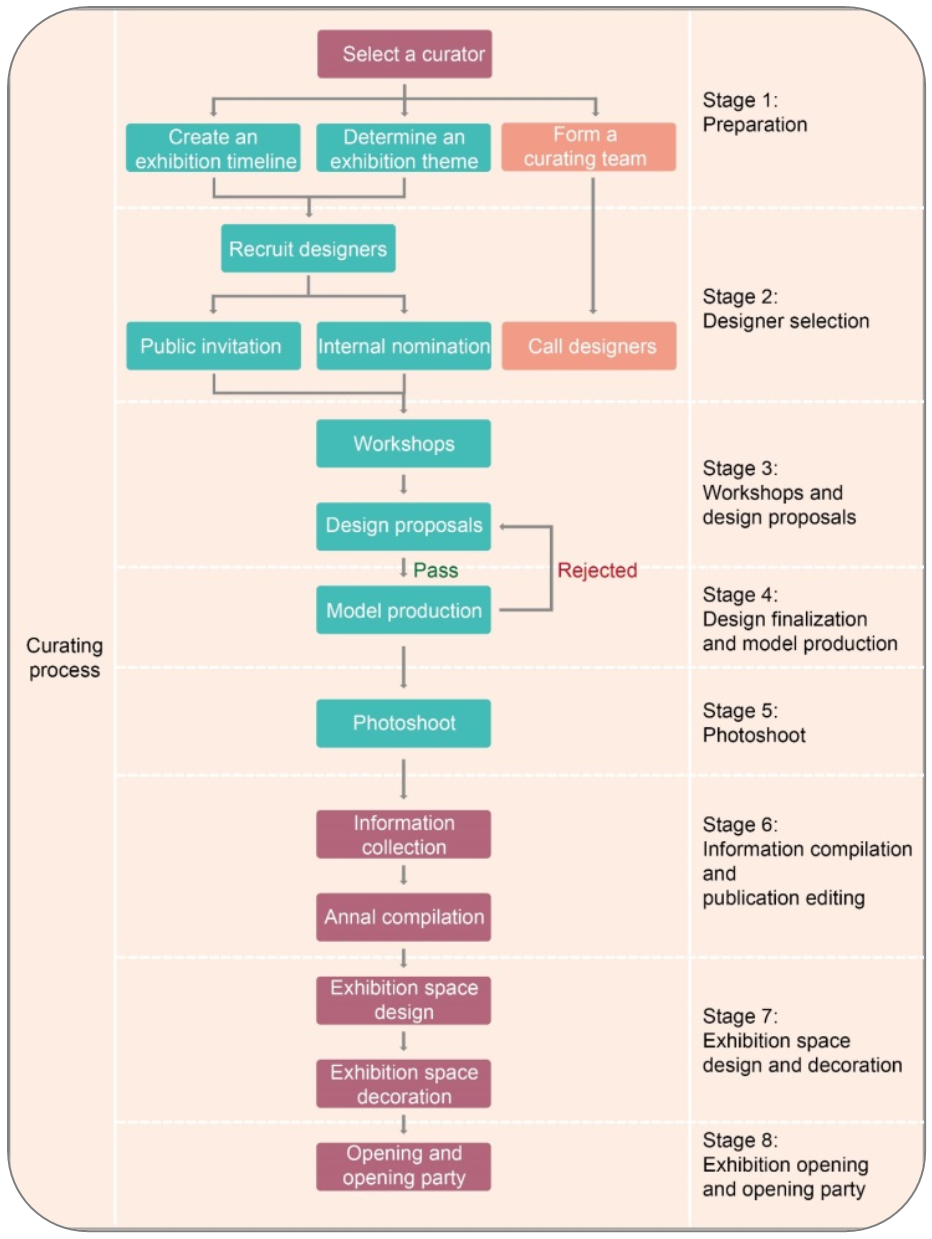 | Figure 6. Curating process employed by Go with the East wind |
3.3. Designers of Go with the East Wind
- A total of 16, 30, and 54 designers participated in “2011 Go with the East Wind: Prelude,” “2012 Go with the East Wind: Memory Gather,” and “2013 Go with the East Wind: Guanyin,” respectively. These designers included professional product designers and professors.
 | Figure 7. Designers who participated in “2012 Go with the East wind: Memory Gather” |
3.4. Products Designed by Go with the East Wind
- From 2011 to 2013, Go with the East Wind generated a total of 54 products for the exhibitions they participated in, some of which are demonstrated as follows:
 | Figure 8. Cultural and creative products designed by Go with the East wind |
3.5. Taiwanese Design Styles Portrayed in the Products Designed by Go with the East Wind
- This study conducted expert meetings by inviting five professionals (including curators and design consultants from Go with the East Wind) to analyze the 54 exhibition items designed by Go with the East Wind. The following aspects were examined: (1) Taiwanese design styles; (2) application of composite materials; and (3) correlation between exhibition items and Taiwanese local cultures.After several meetings, these five professionals suggested that the 54 exhibition items exhibited unique Taiwanese design styles. By analyzing these styles, the professionals generalized and identified the following 9 design guidelines:
3.5.1. Product Design Guidelines Generated by Examining the Products of Go with the East Wind
- 1. Fusion between the East and the West: A combination of Eastern and Western elements can result in designs that convey Eastern concepts in Western forms. 2. Integration of various materials: A combination of different materials generates functional and conceptual conflicts.3. Application of figure–ground reversal and negative space: A reversal of the real subject and the space around the subject can create a visual uncertainty.4. Personification of design: Personification imbues life into inanimate objects.5. Cognitive impact: A change of materials can the viewer’s perceptions toward an object, leading to visual and cognitive conflicts (for instance, by using soft metal and hard clothes).6. Warmth from simplicity: Simplicity generally involves using objects with cold, emotionless implications. However, materials with warm and positive implications are often used in “simplified” products instead in Taiwan to generate friendly and cozy feelings.7. Green design: An integration of innovative technologies with environmental friendly materials can achieve environmental protection.8. Natural aesthetics: The use of natural and native materials from Taiwan creates plain and simple aesthetics in a product.9. Innovative use of materials: The use of innovative technologies strengthens the characteristics, ductility, and malleability of the materials.10. Reflection of past memories: Incorporating old elements into the product by using abstract design concepts can resurrect past memories in users.
3.5.2. Correlation Analysis of the Products and Taiwanese Local Cultures and Techniques
- By examining the 54 exhibition items designed by Go with the East Wind, this study determined that, when creating new and trendy crafts and designs, the designers from this association generally tended to choose cultural elements in accordance with their personal experiences and perceptions because they were all Taiwanese residents who were familiar with Taiwanese cultures and traditional arts. To examine the designers’ design and innovation capabilities, this study analyzed the correlation between their products and Taiwanese local cultures and techniques by dividing the products into five clusters. The following correlations were determined:Cluster A: strong Taiwanese stylesThe products in this cluster exhibited the highest correlation with Taiwanese local cultures and techniques and involved the use of Taiwanese local craftsmanship or materials such as bamboo art from Nantou, LIN's Ceramics Studio’s typical material volcanic mud, wood art from Daxi, and ceramic art from Yingge. Additionally, Taiwanese local cultures (including Taiwanese tea ceremony, temples, and Chinese mythology) were incorporated, engendering a strong influence from Taiwanese styles.Cluster B: distinguishable Taiwanese stylesThe products in this cluster exhibited a lower correlation with Taiwanese local techniques than those in Cluster A because some of these products did not apply techniques from Taiwanese local industries. However, the products in this cluster showed a high correlation with Taiwanese local cultures because they applied foreign techniques to recreate local cultures. Because of these techniques, these products (including a Chinese loop chair and an iron door from a military village in Taiwan) showed a distinguishable influence from Taiwanese styles. Cluster C: indistinguishable Taiwanese StylesThe products in this cluster (including Taiwanese cement bricks and a lattice window) exhibited the lowest correlation with Taiwanese local techniques but a high correlation with Taiwanese local cultures. Therefore, the products exhibited a faintly distinguishable influence from Taiwanese styles.Cluster D: nondistinguishable Taiwanese stylesThe products in this cluster exhibited the highest correlation with Taiwanese local techniques (including bamboo art craftsmanship and bamboo color preservation methods from Nantou) but a relatively low correlation with Taiwanese local cultures compared with those in the previous clusters. Thus, these products showed a nondistinguishable influence from Taiwanese styles.Cluster E: lack of Taiwanese stylesThe products in the cluster exhibited the lowest correlation with Taiwanese local techniques and cultures and thus lacked any influence from Taiwanese styles.
 | Figure 9. Design guidelines for major themes adopted by the Go with the East Wind |
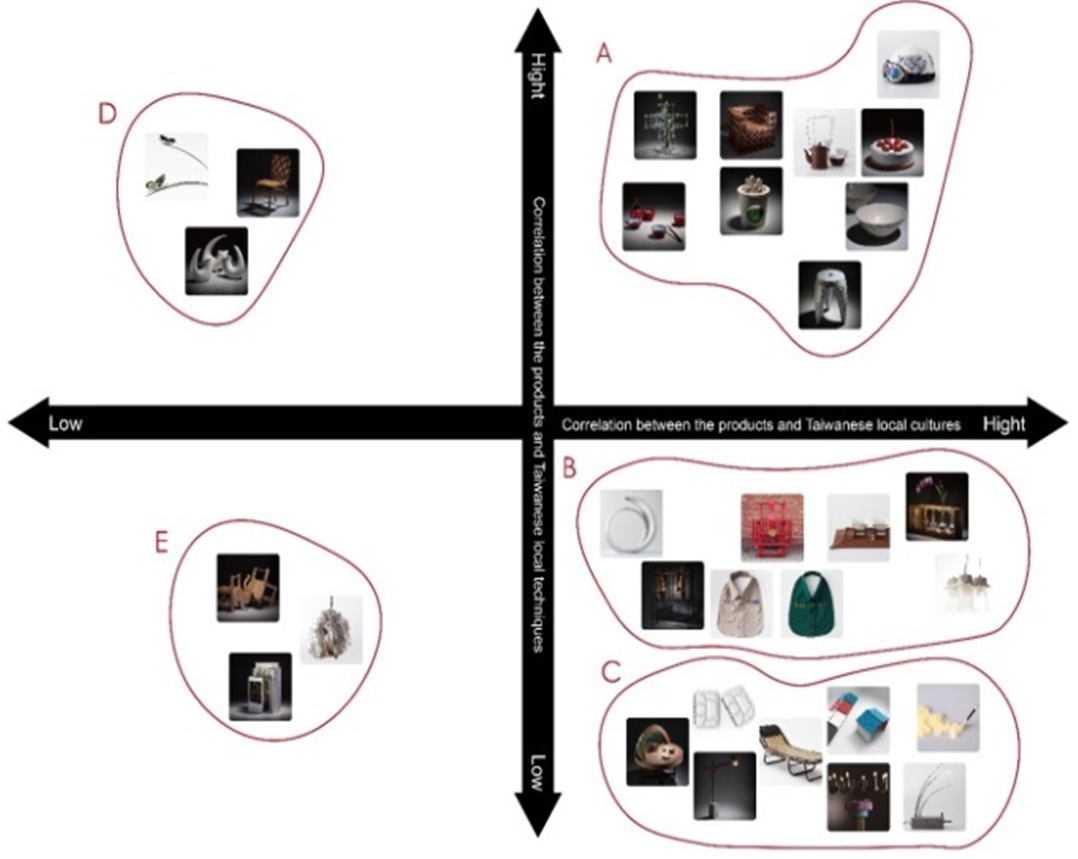 | Figure 10. Correlation between the exhibits and Taiwanese local cultures and techniques |
3.5.3. Material Analysis of the Products
3.5.4. Exhibition Composition
- By examining the curating process (e.g., determining the exhibition content, implementing its execution, and modifying the exhibition in accordance with visitors’ feedback), this study observed that a consistency was achieved in both the internal exhibition theme and the external exhibition display (Figure 12) and generated the following figure to present the composition of the exhibition procedures:
 | Figure 12. Exhibition composition |
3.6. Findings of Expert Opinions
- On the basis of expert opinions, the aforementioned analysis produced the following findings:1. The analysis of Taiwanese design styles revealed that the proposed 10 product design guidelines have been commonly used by modern designers in Taiwan. However, because Taiwanese design styles are still being influenced by worldwide trends, designers in Taiwan have differing opinions on identifying what Taiwanese design styles are. Some experts have suggested that instead of identifying Taiwanese design styles, attention must be paid to the essence of the design and user requirements. This study observed that, because Taiwanese design styles are currently unsettled, designers must mass produce their works to develop benefits and experiences for generating more mature designs. However, the proposed 10 product design guidelines can still serve as a reference for contemporary designers when creating artworks inspired by Taiwanese design styles.2. After substantial promotional results had been achieved in promoting Taiwanese bamboo through the efforts of the National Taiwan Craft Research and Development Institute and the bamboo museums in Nantou, companies or designers in Taiwan began to replace plastic materials with bamboos. In addition, advances in ceramic heating techniques from Yingee and lacquerware-producing methods from Chiayi have gradually enabled the application of Taiwanese local materials as cultural and creative products and information technology products. The 54 exhibition items designed by Go with the East Wind fully exhibited the aesthetic beauty and characteristics of Taiwanese local materials. Thus, the use of local materials may be crucial in developing country-specific design styles. 3. The observed exhibition composition indicated that a chief curator should start by creating a main theme for the exhibition, discussing the cultural value of the theme, and applying the conceived concepts to designing the exhibition space. Moreover, to follow the worldwide trend of environmental protection, a curator must consider the budget limits and recycling potential of the products and displays. Furthermore, a curator must underscore the value of the displays by adding more background information to the art or products and strengthening visitors’ visual memory by using certain design methods to emotionally affect visitors, thereby resulting in more interaction and feedback.
4. Conclusions
- By conducting an expert interview and related field research, this study observed that a curating process does not simply involve gathering designers to generate creative product design concepts, but also includes ensuring that the overall design results constitute a unique form of style or curating framework. After conducting several analyses, this study determined the aspects that are crucial to curating an exhibition, which are listed below:1. Time management generates effectiveness in the curating process: By interviewing three chief curators, this study determined that a successful curating process requires adequate time management when curating a themed exhibition, and that during the curating process, workshops are more useful than conventional approaches for finding mature and adequate themes by encouraging designers to brainstorm. In addition, recruiting a curating consultant can easily increase the quality and effectiveness of an exhibition. 2. Less is not more: Generally, Western designers tend to apply the idea of simplicity to create function-oriented design concepts. However, this study determined that modern products with Taiwanese design styles are not simplistic ones. Moreover, if overly simplified, products fashioned after a Taiwanese style are likely to fail to transfer cultural elements and may not resurrect past memories in users.3. An intelligent integration of traditional craftsmanship and modern techniques: This study observed that the conflicting integration of exquisite Taiwanese craftsmanship and modern techniques results in products that incorporate traditional and modern elements and innovative and trendy craftsmanship results.4. Reflection of the meaning and value of traditional cultures is crucial: Because modern designers are constantly applying innovative technologies and streamlined product forms, this study focused on determining methods to explore the essence of cultures. Thus, curating exhibitions is a critical method for exploring the value of Taiwanese traditional cultures, and can elaborate on the common experiences of Taiwanese people and historic legacies. Therefore, this study confirmed that curating is crucial in creating sustainable development for traditional cultures.5. Design guidelines should not be applied universally: This study conducted expert meetings to formulate a set of design guidelines for developing Taiwanese design styles. However, these guidelines should not be applied universally, because designers should sufficiently adjust the elements of a product depending on locality and its practical functions. For instance, when incorporating Eastern and Western elements by using various materials, designers create innovative concepts by drawing upon personal design experiences and by using certain cueing methods before they generate ideas to add Taiwanese influences to their designs.6. Further application of unexplored materials: Bamboo art from Nantou, ceramics from Yingee, and lacquerware from Chiayi are only a few examples of Taiwanese local and native materials. More materials or techniques are yet to be explored and applied, such as triangle rush weaving techniques from Yuanli, red brick masonry from Pingtung, cedar wood sculptures from Sanyi, and Koji pottery from Chiayi. Thus, curating exhibitions are critical for identifying the meaning and values of Taiwanese local cultures and highlighting traditional industries that contain commercial values to the public.
 Abstract
Abstract Reference
Reference Full-Text PDF
Full-Text PDF Full-text HTML
Full-text HTML